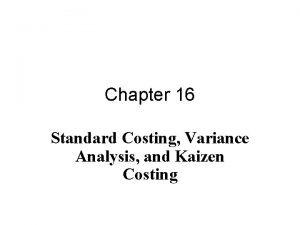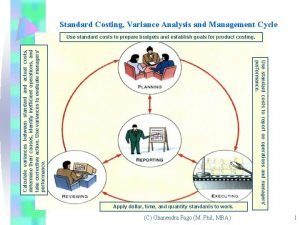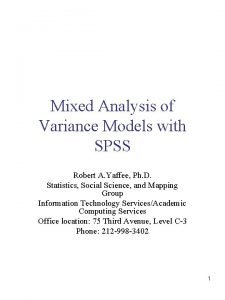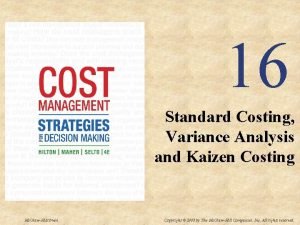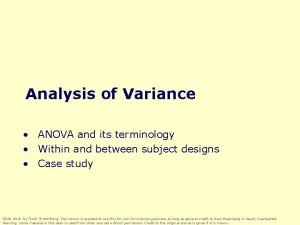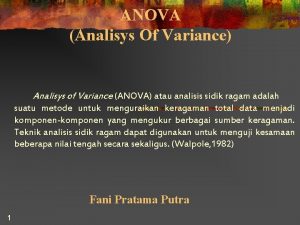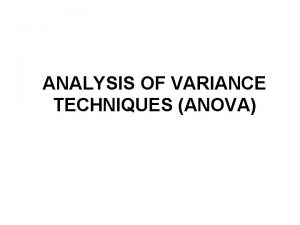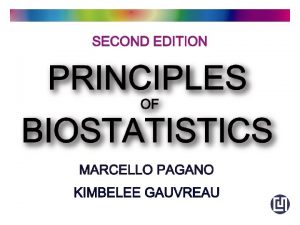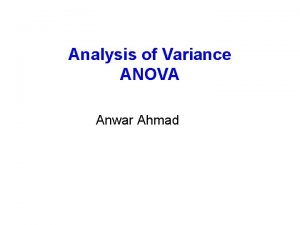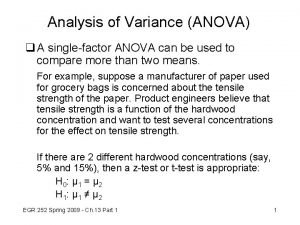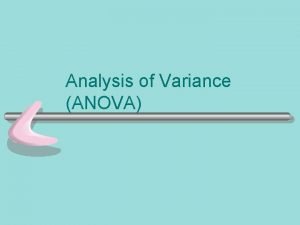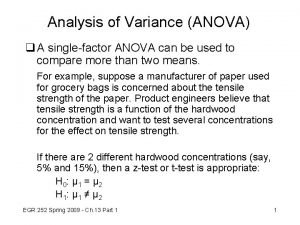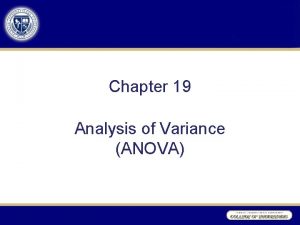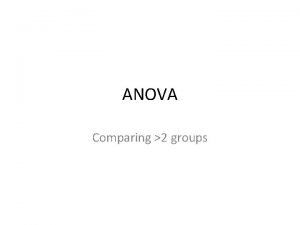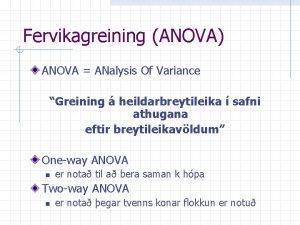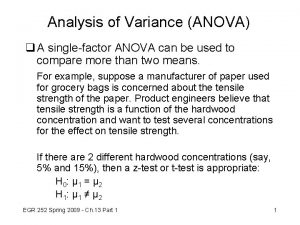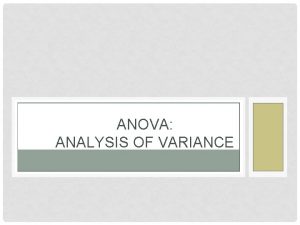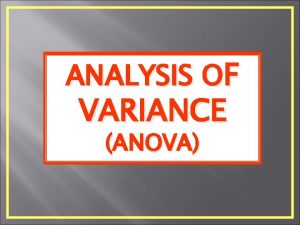Analysis of Variance ANOVA and its terminology Within

























- Slides: 25

Analysis of Variance • ANOVA and its terminology • Within and between subject designs • Case study Slide deck by Saul Greenberg. Permission is granted to use this for non-commercial purposes as long as general credit to Saul Greenberg is clearly maintained. Warning: some material in this deck is used from other sources without permission. Credit to the original source is given if it is known.

Analysis of Variance (Anova) Statistical Workhorse – supports moderately complex experimental designs and statistical analysis – Lets you examine multiple independent variables at the same time – Examples: • There is no difference between people’s mouse typing ability on the Dvorak, Alphabetic and Qwerty keyboard • There is no difference in the number of cavities of people aged under 12, between 12 -16, and older than 16 when using Crest vs No-teeth toothpaste

Analysis of Variance (Anova) Terminology – Factor = independent variable – Factor level = specific value of independent variable Factor Keyboard Qwerty Dvorak Toothpaste type Alphabetic Crest No-teeth Age <12 Factor level 12 -16 >16 Factor level

Anova terminology Factorial design – cross combination of levels of one factor with levels of another – eg keyboard type (3) x expertise (2) Cell – unique treatment combination – eg qwerty x non-typist expertise non-typist Keyboard Qwerty Dvorak Alphabetic

Anova terminology Between subjects (aka nested factors) – subject assigned to only one factor level of treatment – control is general population – advantage: –guarantees independence i. e. , no learning effects – problem: –greater variability, requires more subjects Keyboard Qwerty Dvorak Alphabetic S 1 -20 S 21 -40 S 41 -60 different subjects in each cell

Anova terminology Within subjects (aka crossed factors) –subjects assigned to all factor levels of a treatment –advantages • requires fewer subjects • subjects act as their own control • less variability as subject measures are paired –problems: • order effects Qwerty Keyboard Dvorak Alphabetic S 1 -20 same subjects in each cell

Anova terminology Order effects – within subjects only – doing one factor level affects performance in doing the next factor level, usually through learning – example: • learning to mouse type on any keyboard improves performance on the next keyboard • Alphabetic > Dvorak > Qwerty performance even if there was really no difference between keyboards! S 1: S 2: S 3: S 4: Q Q then D D then A A…

Anova terminology Counter-balanced ordering – mitigates order problem – subjects do factor levels in different orders – distributes the order effect across all conditions, but does not remove them – Fails if order effects are not the equal between conditions • people’s performance improves when starting on Qwerty but worsens when starting on Dvorak S 1: S 2: S 3: S 4: Q then D then A then Q then D Q then A then D…

Anova terminology Mixed factor – contains both between and within subject combinations – within subjects: keyboard type – between subjects: expertise Keyboard Qwerty Dvorak non-typist S 1 -20 typist S 21 -40 Alphabetic

Single Factor Analysis of Variance Compare means between two or more factor levels within a single factor example: – dependent variable: mouse-typing speed – independent variable (factor): keyboard – between subject design Qwerty S 1: 25 secs S 2: 29 … S 20: 33 Keyboard Alphabetic Dvorak S 21: 40 secs S 22: 55 … S 40: 33 S 51: 17 secs S 52: 45 … S 60: 23

Anova Compares relationships between many factors In reality, we must look at multiple variables to understand what is going on Provides more informed results – considers the interactions between factors

Anova Interactions Example interaction – typists are faster on Qwerty than the other keyboards – non-typists perform the same across all keyboards – cannot simply say that one keyboard is best Qwerty Alphabetic Dvorak non-typist S 1 -S 10 S 11 -S 20 S 21 -S 30 typist S 31 -S 40 S 41 -S 50 S 51 -S 60

Anova - Interactions Example: 5 – t-test: crest vs no-teeth • subjects who use crest have fewer cavities 0 crest no-teeth – anova: toothpaste x age • subjects 14 or less have fewer cavities with crest. • subjects older than 14 have fewer cavities with no-teeth. 5 – interpretation? • the sweet taste of crest makes kids use it more, while it repels older folks age >14 age 7 -14 cavities age 0 -6 0 crest no-teeth

Anova case study The situation – text-based menu display for large telephone directory – names listed as a range within a selectable menu item – users navigate menu until unique names are reached 1) Arbor - Kalmer 2) Kalmerson - Ulston 3) Unger - Zlotsky 1) Arbor 2) Farston 3) Hover - Farquar - Hoover - Kalmer … 1) Horace - Horton 2) Hoster, James 3) Howard, Rex

Anova case study The problem – we can display these ranges in several possible ways – expected users have varied computer experiences General question – which display method is best for particular classes of user expertise?

Range Delimeters Full 1) Arbor 2) Barrymore 3) Danby 4) Farquar 5) Kalmerson 6) Moriarty 7) Proctor 8) Sagin 9) Unger - Barney - Dacker - Estovitch - Kalmer - Moreen - Praleen - Sageen - Ulston - Zlotsky Lower Upper 1) Arbor 2) Barrymore 3) Danby 4) Farquar 5) Kalmerson 6) Moriarty 7) Proctor 8) Sagin 9) Unger --(Zlotsky) -- (Arbor) 1) Barney 2) Dacker 3) Estovitch 4) Kalmer 5) Moreen 6) Praleen 7) Sageen 8) Ulston 9) Zlotsky

Range Delimeters Full None Upper 1) Arbor 2) Barrymore 3) Danby 4) Farquar 5) Kalmerson 6) Moriarty 7) Proctor 8) Sagin 9) Unger - Barney - Dacker - Estovitch - Kalmer - Moreen - Praleen - Sageen - Ulston - Zlotsky 1) Arbor 2) Barrymore 3) Danby 4) Farquar 5) Kalmerson 6) Moriarty 7) Proctor 8) Sagin 9) Unger --(Zlotsky) -- (Arbor) 1) Barney 2) Dacker 3) Estovitch 4) Kalmer 5) Moreen 6) Praleen 7) Sageen 8) Ulston 9) Zlotsky 1) A 2) Barr 3) Dan 4) F 5) Kalmers 6) Mori 7) Pro 8) Sagi 9) Un - Barn - Dac -E - Kalmerr - More - Pra - Sage - Ul -Z 1) A 2) Barr 3) Dan 4) F 5) Kalmers 6) Mori 7) Pro 8) Sagi 9) Un --(Z) -- (A) 1) Barn 2) Dac 3) E 4) Kalmera 5) More 6) Pra 7) Sage 8) Ul 9) Z Truncation Truncated Lower

Span as one descends the menu hierarchy, name suffixes become similar Span Wide Span 1) Arbor 2) Barrymore 3) Danby 4) Farquar 5) Kalmerson 6) Moriarty 7) Proctor 8) Sagin 9) Unger --(Zlotsky) Narrow Span 1) Danby 2) Danton 3) Desiran 4) Desis 5) Dolton 6) Dormer 7) Eason 8) Erick 9) Fabian --(Farquar)

Null Hypothesis – six menu display systems based on combinations of truncation and range delimiter methods do not differ significantly from each other as measured by people’s scanning speed and error rate – menu span and user experience has no significant effect on these results – 2 2 2 3 level (truncation) x (menu span) x (experience) x (delimiter) Truncated Full Upper Lower Not Truncated narrow wide Novice S 1 -8 Expert S 9 -16 Novice S 17 -24 Expert S 25 -32 Novice S 33 -40 Expert S 40 -48

Statistical results Scanning speed F-ratio. Range delimeter (R) 2. 2* Truncation (T) 0. 4 Experience (E) 5. 5* Menu Span (S) 216. 0** Rx. T 0. 0 Rx. E 1. 0 Rx. S 3. 0 Tx. E 1. 1 Tx. S 14. 8* Ex. S 1. 0 Rx. Tx. E 0. 0 Rx. Tx. S 1. 0 Rx. Ex. S 1. 7 Tx. Ex. S 0. 3 Rx. Tx. Ex. S 0. 5 p <0. 5 <0. 01 <0. 5

Statistical results Scanning speed: • Truncation x Span Main effects (means) 6 truncated not truncated speed Full Lower Upper Span: narrow Lower 1. 15* ---- Wide Narrow 4. 35 5. 54 Experience Novice Expert 5. 44 4. 36 4 wide Full ---- Results on Selection time • Full range delimiters slowest • Truncation has very minor effect on time: ignore • Narrow span menus are slowest • Novices are slower Upper 1. 31* 0. 16 ----

Statistical results Error rate F-ratio. Range delimeter (R) 3. 7* Truncation (T) 2. 7 Experience (E) 5. 6* Menu Span (S) 77. 9** Rx. T 1. 1 Rx. E 4. 7* Rx. S 5. 4* Tx. E 1. 2 Tx. S 1. 5 Ex. S 2. 0 Rx. Tx. E 0. 5 Rx. Tx. S 1. 6 Rx. Ex. S 1. 4 Tx. Ex. S 0. 1 Rx. Tx. Ex. S 0. 1 p <0. 5 <0. 01 <0. 5

Statistical results Error rates Range x Experience Range x Span lower 16 16 full novice errors upper errors expert 0 full upper lower Results on Errors 0 wide narrow – more errors with lower range delimiters at narrow span – truncation has no effect on errors – novices have more errors at lower range delimiter

Conclusions Upper range delimiter is best Truncation up to the implementers Keep users from descending the menu hierarchy Experience is critical in menu displays

You now know Anova terminology – factors, levels, cells – factorial design • between, within, mixed designs You should be able to: Find a paper in CHI proceedings that uses Anova Draw the Anova table, and state dependant variables independant variables / factors factor levels between/within subject design
 Mancova
Mancova Perbedaan one way dan two way anova
Perbedaan one way dan two way anova One way anova vs two way anova
One way anova vs two way anova Contoh soal analisis varians
Contoh soal analisis varians Anova within group and between group
Anova within group and between group Rsq in standard costing
Rsq in standard costing Within group variance vs between group
Within group variance vs between group What are the advantages of flexible budget
What are the advantages of flexible budget Multivariate analysis of variance and covariance
Multivariate analysis of variance and covariance Standard cost variance
Standard cost variance Flexible budget variance example
Flexible budget variance example Analysis of variance and covariance
Analysis of variance and covariance Material price variance
Material price variance I comb its hair and love its shining eyes
I comb its hair and love its shining eyes Its halloween its halloween the moon is full and bright
Its halloween its halloween the moon is full and bright Static budget variance example
Static budget variance example The variance analysis cycle:
The variance analysis cycle: Tr
Tr Multivariate analysis of variance example
Multivariate analysis of variance example Direct materials variances
Direct materials variances Standard costing meaning
Standard costing meaning Spss mixed model
Spss mixed model Variance analysis in nursing
Variance analysis in nursing Introduction to analysis of variance
Introduction to analysis of variance Difference between kaizen costing and standard costing
Difference between kaizen costing and standard costing Manufacturing cost variance analysis
Manufacturing cost variance analysis







